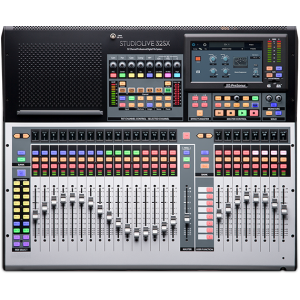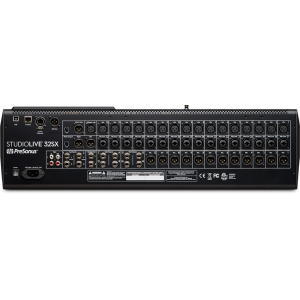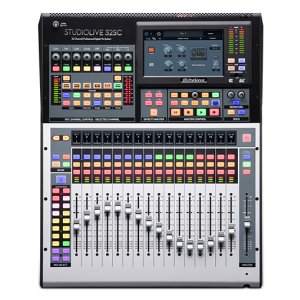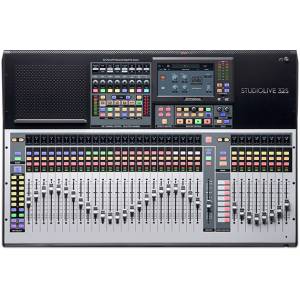PRESONUS STUDIOLIVE 32SX Serie III
MIXER DIGITALE
StudioLive 32SX rappresenta la perfetta soluzione per chi è alla ricerca di una console con le caratteristiche che hanno reso famosi i mixer PreSonus: potenza di processamento, qualità audio ai massimi livelli ed ottima flessibilità sul routing.
Grazie alla potenza di calcolo del dual-core FLEX DSP Engine, StudioLive 32SX gestisce 40 canali di mixing, 26 mix buses e 286 processori di segnale in contemporanea — compresi 4 riverberi stereo e plug-in Fat Channel su ciascun ingresso e mix.
Le dimensioni compatte di StudioLive 32SX permettono di posizionarlo facilmente, anche in postazioni o studi in cui lo spazio è ridotto, mentre la configurazione split-fader permette di gestire 32 canali di input in due fader layers, potendo contemporaneamente controllare le uscite mix con 8 fader separati.
Con 32 preampli microfonici XMAX e 16 uscite mix bilanciate, StudioLive 32SX riesce ad unire efficiente uso dello spazio con potenza ed ottima connettività.
CARATTERISTICHE TECNICHE:
Powered by the new dual-core PreSonus FLEX DSP Engine to provide the most processing of any digital mixer in its class
40 input-channel digital mixer with 25 touch-sensitive motorized faders
32 local digitally controlled XMAX mic/line inputs
2 balanced stereo aux inputs
1 stereo tape input (RCA, USB, AVB or SD)
4 FLEX FX returns
1 Talkback
26 mix buses
16 FlexMixes (Aux, Subgroup, Matrix)
4 dedicated FLEX FX buses
4 dedicated subgroups
Stereo Main bus
286 simultaneous processors
HPF
Gate / Expander
Compressor with Fat Channel plug-in models
4-band/6-band parametric EQ with Fat Channel plug-in models
Limiter
31-band Graphic EQ
4 FLEX FX slots featuring legendary classic reverb emulations and delays
State Space-Modeled Fat Channel compressor and EQ plug-ins available on every input channel and output bus
FLEX FX multi-effects processor with 4 slots to load legendary reverb emulations and delays with 4 dedicated effects buses
24 DCAs to control groups of channels
128-channel (64x64) recording over USB
Onboard multi-channel SD recorder (34x34) with true Virtual Soundcheck mode
AVB Networking onboard (64x64) to connect with other mixers, NSB-series stage boxes, EarMix 16M personal monitor mixers and more
User Profiles for managing multiple operators with custom permissions
Per channel digital patching from any analog, AVB, USB, or SD Card source
DAW Control
Advanced Studio One control integration
MCU emulation mode optimized for Logic
HUI emulation mode optimized for ProTools
Remote control every mix function from your computer, iPad, or Android tablet with UC Surface (included)
Put your musicians’ monitor mix under their fingers with QMix-UC (included) for iOS or Android
Capture 3.0 multitrack software included
Automated Virtual Soundcheck
Store StudioLive mix scenes with your audio
Advanced Studio One integration (Studio One Artist Included)
XMAX mic preamp control from Studio One
Control Fat Channel parameters from Studio One mixing console
SPECIFICHE TECNICHE:
MICROPHONE PREAMPLIFIER
Input Type
XLR Female, balanced
Frequency Response to Main Output (at unity gain)
20-20 kHz, ±0.5 dBu
Input Impedance
1 k?
THD to Main Output
<0.005%, +4 dBu, 20-20 kHz, unity gain, unwtd
S/N Ratio to Main Output (Ref = +4 dB, 20 kHz BW, unity gain, A-wtd)
94 dB
Common Mode Rejection Ratio (1 kHz at unity gain)
65 dB
Gain Control Range (±1 dB)
0 dB to +60 dB
Maximum Input Level (unity gain)
+12 dBu
Phantom Power (±2 VDC)
48 VDC, switchable per channel
LINE INPUTS
Type
¼” TRS Female, balanced
Frequency Response to Main Output (at unity gain)
20-20 kHz, ±0.5 dBu
Input Impedance
10 k?
THD to Main Output
<0.005%, +4 dBu, 20-20 kHz, unity gain, unwtd
S/N Ratio to Main Output (Ref = +4 dB, 20 kHz BW, unity gain, A-wtd)
94 dB
Maximum Input Level
+18 dBu
TAPE INPUTS
Type
RCA Female, unbalanced (stereo pair)
Maximum Input Level
+12 dBu, ±0.5 dBu
XLR OUTPUTS
Type
XLR Male, balanced
Maximum Output Level
+24 dBu, ±0.5 dBu
Output Impedance
100?
LINE OUTPUTS
Type
¼” TRS Female, balanced
Maximum Output Level
+18 dBu, ±0.5 dBu
Output Impedance
100?
TAPE OUTPUTS
Type
RCA Female, unbalanced (stereo pair)
Maximum Output Level
+18 dBu, ±0.5 dBu
Output Impedance
100?
HEADPHONE OUTPUT
Type
¼” TRS Female, active stereo
Maximum Output
100 mW/ch. @ 60? load
Frequency Response
20 Hz – 20 kHz (± 0.5 dB)
THD+N
0.01%, 1 kHz, max gain, 20 Hz BW, unwtd
S/N Ratio
96 dB, 1 kHz, max gain, 20 Hz BW, unwtd
SYSTEM CROSSTALK
Input to Output
-90 dB (Ref = +4 dBu, 20 Hz-20 kHz, unwtd)
Adjacent Channels
-87 dB (Ref = +4 dBu, 20 Hz-20 kHz, unwtd)
DIGITAL AUDIO AND CONTROL
ADC Dynamic Range
115 dB (A-wtd, 48 kHz)
DAC Dynamic Range
115 dB (A-wtd, 48 kHz)
USB Recording Port
USB 2.0, Type-B
AES/EBU Output
XLR Male
Network Control Port
RJ-45
AVB Audio Network Port
Locking XLR Ethernet
Internal Processing
32-bit, ?oating point
Sampling Rate
48 kHz, 44.1 kHz
A/D/A Bit Depth
24
Reference Level for 0 dBFS
+18 dBu
Total System Latency
1.9 ms (local routing, analog in-analog out, all processing active)
CLOCK
Jitter
<20 ps RMS (20 Hz - 20 kHz)
Jitter Attenuation
>60 dB (1 ns in, 1 ps out)
POWER / ENVIRONMENTAL
Connector
IEC
Input-Voltage Range
90 to 230 VAC (±10%)
Power Requirements (continuous)
85W
Recommended Ambient Operating Temperature
0? to 40? Celsius / 32? to 104? Fahrenheit
PHYSICAL
Height
6.51” (165.36 mm)
Width
25.98” (659.81 mm)
Depth
22.97” (583.84 mm)
Weight
30 lbs. (13.6 kg)
As a commitment to constant improvement, PreSonus® Audio Electronics, Inc., reserves the right to change any specification stated herein, at any time, without notification.
Grazie alla potenza di calcolo del dual-core FLEX DSP Engine, StudioLive 32SX gestisce 40 canali di mixing, 26 mix buses e 286 processori di segnale in contemporanea — compresi 4 riverberi stereo e plug-in Fat Channel su ciascun ingresso e mix.
Le dimensioni compatte di StudioLive 32SX permettono di posizionarlo facilmente, anche in postazioni o studi in cui lo spazio è ridotto, mentre la configurazione split-fader permette di gestire 32 canali di input in due fader layers, potendo contemporaneamente controllare le uscite mix con 8 fader separati.
Con 32 preampli microfonici XMAX e 16 uscite mix bilanciate, StudioLive 32SX riesce ad unire efficiente uso dello spazio con potenza ed ottima connettività.
CARATTERISTICHE TECNICHE:
Powered by the new dual-core PreSonus FLEX DSP Engine to provide the most processing of any digital mixer in its class
40 input-channel digital mixer with 25 touch-sensitive motorized faders
32 local digitally controlled XMAX mic/line inputs
2 balanced stereo aux inputs
1 stereo tape input (RCA, USB, AVB or SD)
4 FLEX FX returns
1 Talkback
26 mix buses
16 FlexMixes (Aux, Subgroup, Matrix)
4 dedicated FLEX FX buses
4 dedicated subgroups
Stereo Main bus
286 simultaneous processors
HPF
Gate / Expander
Compressor with Fat Channel plug-in models
4-band/6-band parametric EQ with Fat Channel plug-in models
Limiter
31-band Graphic EQ
4 FLEX FX slots featuring legendary classic reverb emulations and delays
State Space-Modeled Fat Channel compressor and EQ plug-ins available on every input channel and output bus
FLEX FX multi-effects processor with 4 slots to load legendary reverb emulations and delays with 4 dedicated effects buses
24 DCAs to control groups of channels
128-channel (64x64) recording over USB
Onboard multi-channel SD recorder (34x34) with true Virtual Soundcheck mode
AVB Networking onboard (64x64) to connect with other mixers, NSB-series stage boxes, EarMix 16M personal monitor mixers and more
User Profiles for managing multiple operators with custom permissions
Per channel digital patching from any analog, AVB, USB, or SD Card source
DAW Control
Advanced Studio One control integration
MCU emulation mode optimized for Logic
HUI emulation mode optimized for ProTools
Remote control every mix function from your computer, iPad, or Android tablet with UC Surface (included)
Put your musicians’ monitor mix under their fingers with QMix-UC (included) for iOS or Android
Capture 3.0 multitrack software included
Automated Virtual Soundcheck
Store StudioLive mix scenes with your audio
Advanced Studio One integration (Studio One Artist Included)
XMAX mic preamp control from Studio One
Control Fat Channel parameters from Studio One mixing console
SPECIFICHE TECNICHE:
MICROPHONE PREAMPLIFIER
Input Type
XLR Female, balanced
Frequency Response to Main Output (at unity gain)
20-20 kHz, ±0.5 dBu
Input Impedance
1 k?
THD to Main Output
<0.005%, +4 dBu, 20-20 kHz, unity gain, unwtd
S/N Ratio to Main Output (Ref = +4 dB, 20 kHz BW, unity gain, A-wtd)
94 dB
Common Mode Rejection Ratio (1 kHz at unity gain)
65 dB
Gain Control Range (±1 dB)
0 dB to +60 dB
Maximum Input Level (unity gain)
+12 dBu
Phantom Power (±2 VDC)
48 VDC, switchable per channel
LINE INPUTS
Type
¼” TRS Female, balanced
Frequency Response to Main Output (at unity gain)
20-20 kHz, ±0.5 dBu
Input Impedance
10 k?
THD to Main Output
<0.005%, +4 dBu, 20-20 kHz, unity gain, unwtd
S/N Ratio to Main Output (Ref = +4 dB, 20 kHz BW, unity gain, A-wtd)
94 dB
Maximum Input Level
+18 dBu
TAPE INPUTS
Type
RCA Female, unbalanced (stereo pair)
Maximum Input Level
+12 dBu, ±0.5 dBu
XLR OUTPUTS
Type
XLR Male, balanced
Maximum Output Level
+24 dBu, ±0.5 dBu
Output Impedance
100?
LINE OUTPUTS
Type
¼” TRS Female, balanced
Maximum Output Level
+18 dBu, ±0.5 dBu
Output Impedance
100?
TAPE OUTPUTS
Type
RCA Female, unbalanced (stereo pair)
Maximum Output Level
+18 dBu, ±0.5 dBu
Output Impedance
100?
HEADPHONE OUTPUT
Type
¼” TRS Female, active stereo
Maximum Output
100 mW/ch. @ 60? load
Frequency Response
20 Hz – 20 kHz (± 0.5 dB)
THD+N
0.01%, 1 kHz, max gain, 20 Hz BW, unwtd
S/N Ratio
96 dB, 1 kHz, max gain, 20 Hz BW, unwtd
SYSTEM CROSSTALK
Input to Output
-90 dB (Ref = +4 dBu, 20 Hz-20 kHz, unwtd)
Adjacent Channels
-87 dB (Ref = +4 dBu, 20 Hz-20 kHz, unwtd)
DIGITAL AUDIO AND CONTROL
ADC Dynamic Range
115 dB (A-wtd, 48 kHz)
DAC Dynamic Range
115 dB (A-wtd, 48 kHz)
USB Recording Port
USB 2.0, Type-B
AES/EBU Output
XLR Male
Network Control Port
RJ-45
AVB Audio Network Port
Locking XLR Ethernet
Internal Processing
32-bit, ?oating point
Sampling Rate
48 kHz, 44.1 kHz
A/D/A Bit Depth
24
Reference Level for 0 dBFS
+18 dBu
Total System Latency
1.9 ms (local routing, analog in-analog out, all processing active)
CLOCK
Jitter
<20 ps RMS (20 Hz - 20 kHz)
Jitter Attenuation
>60 dB (1 ns in, 1 ps out)
POWER / ENVIRONMENTAL
Connector
IEC
Input-Voltage Range
90 to 230 VAC (±10%)
Power Requirements (continuous)
85W
Recommended Ambient Operating Temperature
0? to 40? Celsius / 32? to 104? Fahrenheit
PHYSICAL
Height
6.51” (165.36 mm)
Width
25.98” (659.81 mm)
Depth
22.97” (583.84 mm)
Weight
30 lbs. (13.6 kg)
As a commitment to constant improvement, PreSonus® Audio Electronics, Inc., reserves the right to change any specification stated herein, at any time, without notification.
Le immagini e le descrizioni dei prodotti riproducono nel modo più fedele le caratteristiche degli stessi. Possono peraltro sussistere errori o difformità sull’aspetto e nella descrizione dei beni e dei loro accessori. Le immagini e le descrizioni devono quindi intendersi come indicative. Farà fede la descrizione del prodotto contenuta nel modulo d’ordine.
PRESONUS
PRESONUS
PRESONUS








